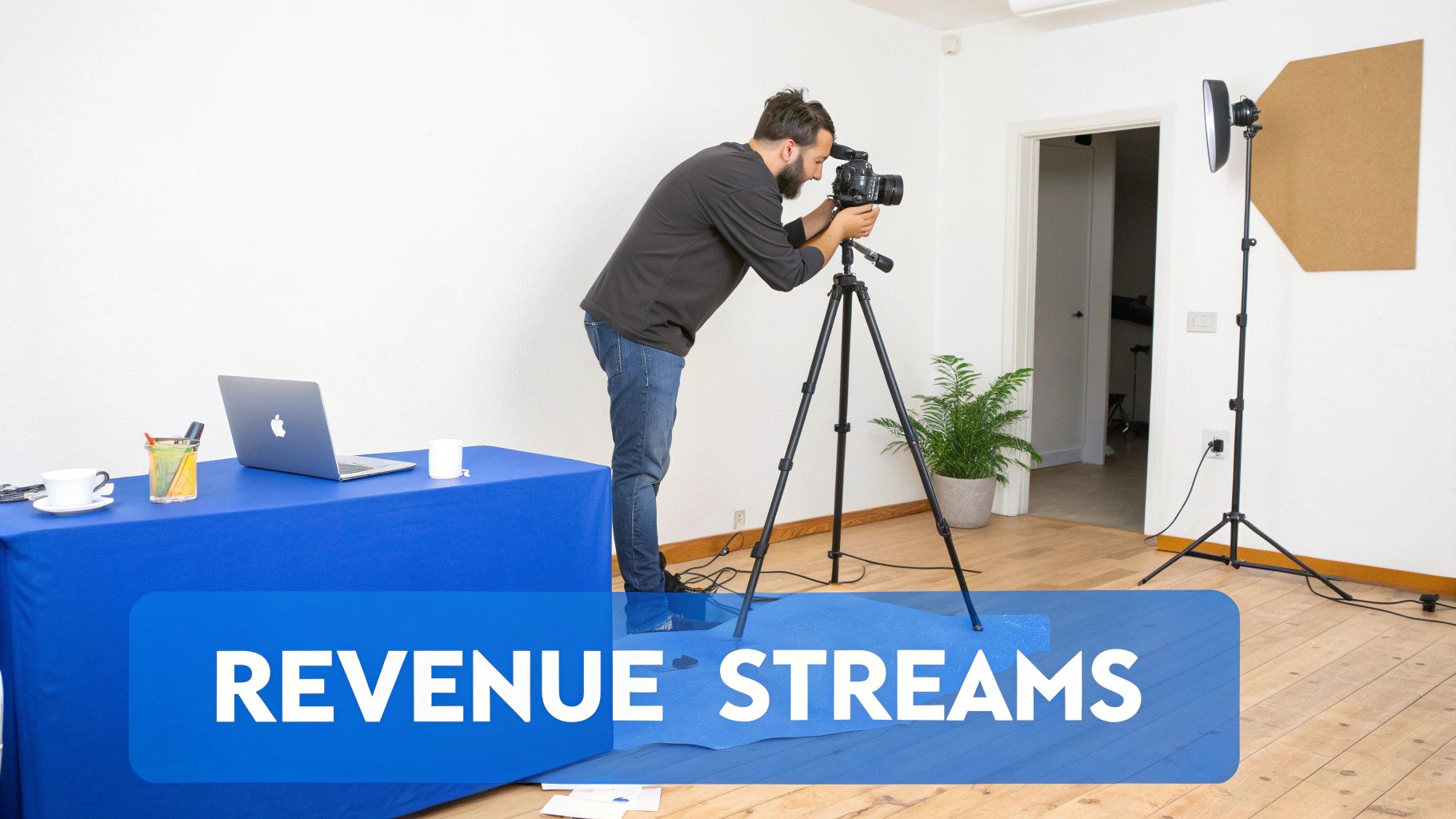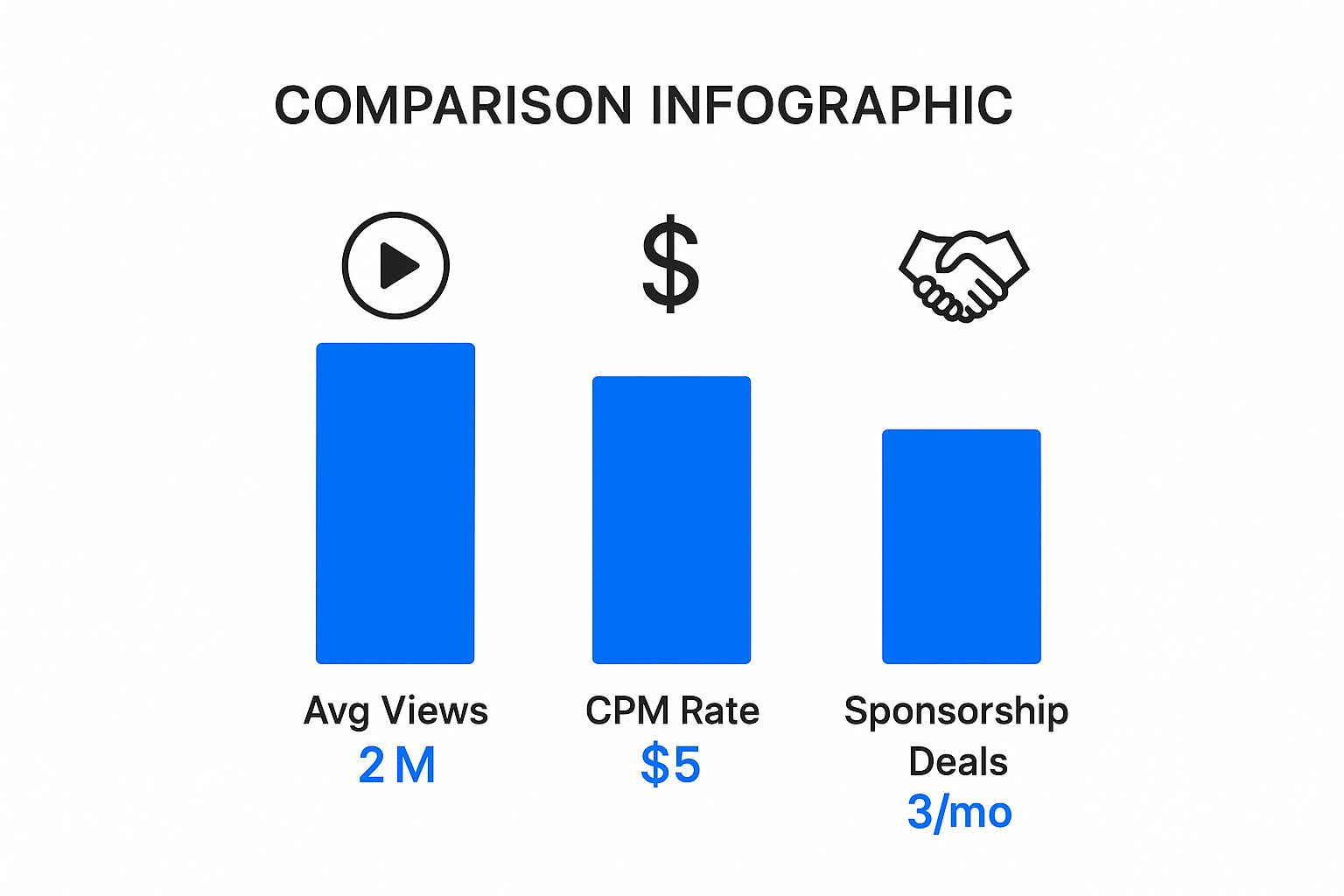How Much Do YouTubers Make? Discover Earnings in India
Wondering how much do YouTubers make in India? Explore real earnings from ads, sponsors, and merch to see what creators at any level can earn.
1 Oct 2025

Ever wondered how much Indian YouTubers actually make? It’s a common question, but the answer is far from simple. Earnings can be anything from a little extra pocket money for a new creator to multi-crore paydays for the platform's biggest stars.
A creator's income isn't just about their subscriber count. It's a dynamic mix of video views, where their audience is from, their content niche, and of course, brand deals.
The Reality of YouTuber Earnings in India
Turning a YouTube hobby into a high-earning career is a marathon, not a sprint. For most creators, the first real goal is just making enough to cover the costs of making their videos. As a channel grows, so does its potential for real income.
It's important to remember that subscriber count can be a vanity metric. What really drives income is consistent viewership from an engaged community. A channel with 50,000 super-active subscribers can easily out-earn another with 200,000 subscribers who barely watch.
Think of it like starting any business. In the beginning, you're putting in a lot of time and effort for very little financial return. But if you stay consistent and have a solid strategy, the revenue starts to build. This is why you can't just put one number on YouTuber earnings; you have to look at the different stages of a creator's journey.
A Snapshot of Earning Potential
To give you a clearer idea, let's break down the potential monthly earnings for Indian creators based on their channel size. These are just estimates and can swing wildly depending on the factors we just talked about. Still, they offer a good benchmark for what's possible.
The key thing to realise is that growth isn't a straight line. Moving from a nano-influencer to a micro-influencer might double your income, but that next jump to the macro-tier can boost it tenfold or even more.
Don't forget that the costs of creating great content also affect what a creator actually takes home. For anyone serious about growing their channel, understanding the video editing cost in India is a crucial part of the budget. Better editing often leads to better engagement and higher ad revenue, making it a smart investment.
To put it all into perspective, here’s a table that breaks down what you might realistically expect to earn at different stages of your YouTube career in India.
Estimated Monthly YouTuber Earnings in India by Subscriber Count
This table provides a snapshot of potential monthly earnings for Indian YouTubers at different stages, from nano-influencers to mega-stars.
Channel Size (Subscribers) | Estimated Monthly Earnings (INR) |
|---|---|
Nano (1k - 10k) | ₹5,000 - ₹30,000 |
Micro (10k - 100k) | ₹30,000 - ₹1,50,000 |
Mid-Tier (100k - 1M) | ₹1,50,000 - ₹8,00,000 |
Macro (1M - 10M) | ₹8,00,000 - ₹50,00,000 |
Mega (10M+) | ₹50,00,000+ |
As you can see, the potential is huge, but it all starts with building a dedicated audience, one video at a time.
How YouTube Ad Revenue Actually Works

For most creators, ad revenue is the bread and butter of their YouTube income. But it's not as simple as getting views and cashing a cheque. The whole system hinges on the YouTube Partner Program (YPP), the gateway for channels to start placing ads on their videos.
Getting into the YPP is a huge milestone. It’s the point where your channel officially shifts from a passion project to a potential business. Once you're in, though, the real learning begins—understanding how that ad money actually makes its way to you.
Getting to Grips with CPM and RPM
To understand what you're earning from ads, you need to know two little acronyms: CPM and RPM. They sound alike, but they measure two completely different things, and both are vital for checking the financial pulse of your channel.
First up is CPM, which stands for Cost Per Mille. This is the amount advertisers are willing to pay for 1,000 ad impressions on videos. A high CPM means advertisers see real value in the audience watching your content.
But you don't get to keep that full amount. YouTube takes a 45% cut from the ad revenue on your videos. This is where the second metric becomes so important.
RPM, or Revenue Per Mille, is what you actually pocket per 1,000 video views after YouTube takes its share. This number is the true measure of what your content is earning from ads.
Because of YouTube's cut, your RPM will always be lower than your CPM. It's the number you should be watching to forecast your income. For anyone new to this, getting into the YPP is the first hurdle; you can learn more by checking out our guide on how to monetise a YouTube channel.
Why Not All Views Are Created Equal
It's a common myth that more views automatically mean more money. The truth is, the value of a single view can swing wildly depending on a few key factors. This is why two channels with identical view counts can have drastically different bank balances.
The two biggest things that move the needle on your RPM are your content niche and where in the world your viewers are watching from.
Your Niche: Advertisers will pay top dollar to get in front of audiences interested in high-value subjects like personal finance or technology. These niches almost always have a higher CPM than comedy or pranks.
Viewer Geography: An advertiser will pay far more for a view from someone in a high-income country like the United States than they will for a view from a region with less purchasing power.
In India, this translates to an average earning of between ₹110 to ₹220 per 1,000 views from ads. These earnings can shoot up when views come from places like the US or UK. It’s why some top Indian YouTubers can reportedly earn anywhere from ₹11.6 lakhs to ₹1.7 crores a month just from their channel's ad revenue.
Earning Beyond Ads with Diverse Income Streams
While YouTube ad revenue is a great starting point, the smartest creators know it’s just one piece of the puzzle. Relying only on ads is risky. The real secret to building a stable income lies in creating a mix of different revenue streams.
Top YouTubers don't just see their channel as a hobby; they run it like a business. This means looking for every opportunity to turn their audience's attention into income, moving way beyond simple ad payouts.
The Power of Brand Sponsorships
For many YouTubers, brand sponsorships are where the real money is. A single sponsored video can bring in thousands, or even lakhs, of rupees. Brands are more than willing to pay good money to get in front of an audience that already trusts you.
The key is to partner with brands that actually make sense for your content and your viewers. When these partnerships feel genuine, your audience appreciates it, and the brand gets fantastic results.
Sponsorship rates can be all over the place. A smaller channel might make between ₹4,000 to ₹25,000 for a video. But a massive creator with over a million subscribers could be looking at ₹1,50,000 to ₹40,00,000+ for just one sponsored post.
Unlocking Earnings with Affiliate Marketing
Affiliate marketing is another brilliant way to make money without a formal brand deal. The idea is simple: you recommend a product you genuinely use and love, and you get a small commission every time someone buys it through your special link.
This works perfectly for channels that do reviews or tutorials. A beauty vlogger can drop affiliate links for all the makeup she used, or a gamer can link to their keyboard, mouse, and headset.
The best thing about affiliate marketing? It's passive. You can put a link in the description of a video, and it can keep earning you money for months, or even years, as people discover and watch it.
The image below gives you a clear picture of how these different income sources stack up for a creator.

As you can see, just a couple of sponsored videos a month can often earn a creator more than millions of views from ads alone.
Tapping into Direct Fan Support
YouTube also has features that let your most loyal fans support you directly. These tools turn casual viewers into paying members of your community, giving you a predictable monthly income.
Here are the main ways fans can support you:
Channel Memberships: Viewers pay a small monthly fee for special perks like custom emojis or members-only videos.
Super Chat & Super Thanks: During live streams, fans can pay to have their comments highlighted. Super Thanks lets them leave a tip on your regular videos.
Many creators also use platforms outside of YouTube to connect with their community. If you're exploring this, checking out a detailed comparison of Ko-fi and Patreon is a great way to figure out which service fits your style best.
Building a Brand with Merchandise and Products
The final step in diversifying your income is to sell your own stuff. This is how you go from being just a content creator to a full-blown brand. This could be as simple as selling t-shirts and mugs with your logo, or you could create more unique digital or physical products.
For instance, an educational channel might sell an online course. A cooking channel could launch their own line of spice blends. This move requires a smart https://behooked.co/blogs/social-media-content-strategy to promote your products effectively.
By building multiple streams of income, you protect yourself from things you can't control, like changes to the YouTube algorithm. This strategic approach is the real answer to "how much do YouTubers make."
What Small YouTubers Can Realistically Earn

When you first start a YouTube channel, it’s crucial to have a realistic idea of what you can earn. For nano and micro-influencers—creators with fewer than 100,000 subscribers—the journey is about building a solid foundation.
Think of it like laying bricks. Every thousand views is another brick in the wall. It feels slow at first, but with consistent effort, those bricks start to form a structure that can eventually support a real income.
Navigating the Early Financial Milestones
That first paycheque won't land in your bank account right away. The initial grind is all about creating content, racking up enough watch time and subscribers to meet YPP's tough entry requirements.
Once you’re in and your channel is monetised, you’ll start earning from ads. For a smaller creator in India, this might not be a fortune, but it's a start. For instance, a YouTuber with around 5,000 subscribers can realistically earn anywhere from ₹5,000 to ₹25,000 a month. This is driven more by your view count than your subscriber number.
How a Small Audience Can Generate Real Income
It's a huge myth that you need millions of subscribers to make decent money. The truth is, a small but highly engaged community can be far more valuable. These are the people who watch every video, jump into the comments, and trust your opinion.
A channel with 20,000 loyal subscribers who actively engage is often more profitable than a channel with 100,000 passive viewers who barely interact.
This is what gets you your first brand deals. Brands are increasingly looking for micro-influencers because their audiences are laser-focused and genuinely listen. A single sponsored video can often bring in more cash than a whole month's worth of ad revenue.
Strategies for Boosting Earnings Early On
As a small creator, you need to diversify your income from day one. Relying only on ad revenue is risky because it can swing wildly from one month to the next.
Here are a few practical ways to start earning more:
Affiliate Marketing: This is the easiest place to start. Pop some affiliate links in your video descriptions for products you genuinely use.
Focus on a Niche: Channels that serve a specific, profitable niche (think personal finance or tech reviews) often have a much higher RPM.
Improve Your Content: Better videos lead to more engagement and longer watch times. Learning https://behooked.co/blogs/how-to-make-viral-youtube-videos can seriously speed up your growth.
By mixing ad revenue with these other income streams, even a small channel can start to generate a reliable side income.
The Business Models of Top Indian YouTubers
For India's biggest YouTube stars, their channel is the central hub of a massive media empire. They've moved way past just earning from ads and have built complex businesses with multiple, high-value income streams.
Their success is a masterclass in turning a personal brand into a full-blown business. The strategies you see from people like Technical Guruji and Bhuvan Bam aren't just about getting millions of views. They’re about smart diversification and powerful brand building.
By breaking down how they do it, any creator can learn valuable lessons. It shows how you can combine huge ad revenues with strategic brand deals, sell-out merchandise lines, and clever investments.
Combining Ad Revenue with High-Value Brand Endorsements
For a top-tier YouTuber, ad revenue is a nice, steady cheque, but it’s often just a fraction of what they earn from brand partnerships. While ads might bring in lakhs every month, a single big-name endorsement can easily match that figure.
These aren't just simple one-off sponsored videos. We're talking about large-scale, long-term collaborations. A top creator might become the face of a brand's entire digital marketing campaign, which means a substantial and reliable income.
The numbers can be mind-boggling. Some of the highest-paid YouTubers in India have built net worths in the hundreds of crores. Gaurav Chaudhary (Technical Guruji) has an estimated net worth of around ₹356 crore. Likewise, Bhuvan Bam has built a net worth of ₹122 crore. You can read more about the richest creators in India on haulpack.com.
Building a Direct-to-Consumer Brand with Merchandise
Another key piece of the puzzle is selling their own stuff. Merchandise is so much more than just slapping a logo on a t-shirt; it’s about turning your viewers into loyal customers.
For the creator, merchandise transforms their personal brand into a direct-to-consumer (D2C) business. This creates a revenue stream that they own and control completely.
The biggest creators often launch entire product lines, from hoodies to digital products. This approach doesn't just bring in serious profit; it also reinforces their brand identity. Creating successful video for branding is crucial to promoting these products genuinely.
Expanding into External Business Ventures
The most business-savvy YouTubers use their channel as a launchpad for businesses that have nothing to do with YouTube itself. With their influence and capital, they can invest in or start new companies. This is the ultimate form of diversification.
These side hustles often make perfect sense with their content niche. For example:
A tech reviewer might open a technology consulting firm.
A comedy creator could start their own production house.
A fitness influencer might launch a line of health supplements.
This kind of strategic expansion protects their wealth from the ups and downs of the content world, solidifying their status as powerful entrepreneurs.
Your Path to a Profitable YouTube Channel

So, you've gone from wondering "how much do YouTubers make?" to wanting to build a profitable channel of your own. That journey is all about strategy and a whole lot of persistence. It means thinking less like a hobbyist and more like an entrepreneur.
The secret to real financial stability on YouTube isn't just one big income source. It’s about smart diversification. Think of ad revenue as your foundation—a great start, but just a start. The real strength comes from layering other income streams on top.
Building Your Monetisation Strategy
Picture your channel as the centre of a wheel with several spokes pointing outwards. Each spoke is a different way you earn money. Your goal is to build out as many of these spokes as possible so that if one income stream takes a hit, you’re not left high and dry.
A solid, diversified strategy usually includes a mix of these:
Ad Revenue: Your bread and butter from the YouTube Partner Programme.
Sponsorships: High-value deals you make directly with brands.
Affiliate Links: A steady trickle of passive income from recommending products.
Memberships: Predictable, recurring income from your most loyal viewers.
This approach turns your channel into a real, sustainable business. Of course, a profitable channel also needs to be a legally sound one. To avoid copyright strikes, it’s crucial to understand how to license music for your videos.
The Real Path to Success
At the end of the day, a profitable YouTube channel comes down to consistent effort and smart thinking. First, you create content that people want to watch. Then, you give that audience multiple ways to support you and your work.
The most successful creators don't just make videos; they build brands. They understand that their influence is an asset that can be nurtured and monetised in many different ways.
This mindset is what separates the creators earning side cash from those building media empires. Your path to profitability isn’t just about making great videos—it’s about building a clever, diversified business around them.
Ready to stop dreaming and start creating? BeHooked uses AI to turn your ideas into studio-quality videos in minutes, handling everything from scripts and editing to music and b-rolls. Skip the complexity and start building your profitable YouTube channel today. Explore BeHooked now.
Conclusion
The journey of a YouTuber in India, from a newcomer to a media mogul, is all about strategic growth. While ad revenue gets you started, true financial success is built on a diverse business model. The top creators channel their influence into high-value brand deals, direct-to-consumer merchandise, and separate business ventures. By treating their channel as the core of a much larger enterprise, they have turned passion into multi-crore empires and set a powerful example for future digital entrepreneurs.
Frequently Asked Questions
How many views do you need to make ₹10,000 in India?
There's no single answer, as it depends on your niche and audience. But as a rough guide, with an average RPM (Revenue Per Mille) of about ₹110-₹220 per 1,000 views, you'd typically need somewhere between 45,000 and 90,000 monetised views to earn ₹10,000 from ads alone.
Do subscribers affect how much you earn on YouTube?
Subscribers don't pay you directly, but having a large subscriber base usually means more consistent views on your new videos, which boosts your ad revenue. Subscribers are also the heart of your community—the people most likely to support you through channel memberships, Super Chats, and buying your merchandise.
How long does it take to start earning money on YouTube?
It's different for everyone. First, you have to hit the YouTube Partner Programme requirements: 1,000 subscribers and 4,000 hours of watch time within 12 months. Some creators get there in a few months; for others, it can take over a year. After that, building a real income depends on your content quality, consistency, and monetisation strategy.